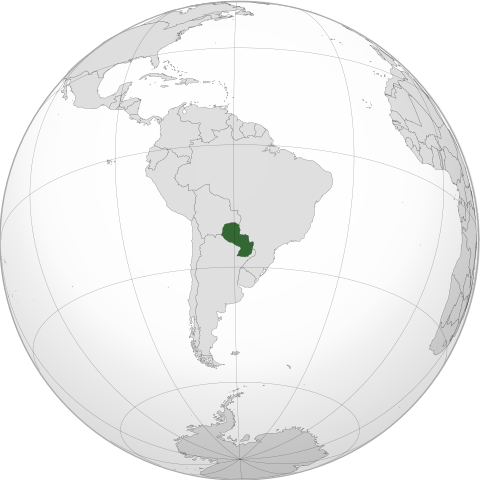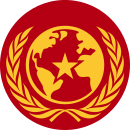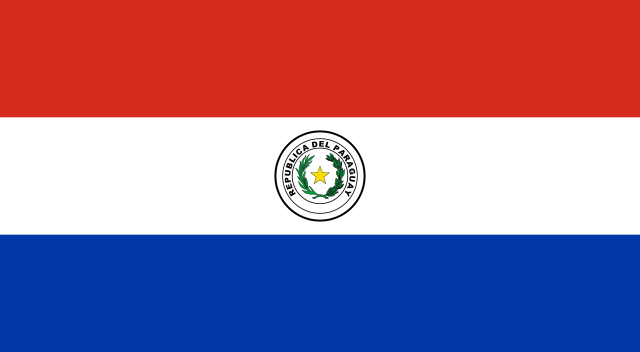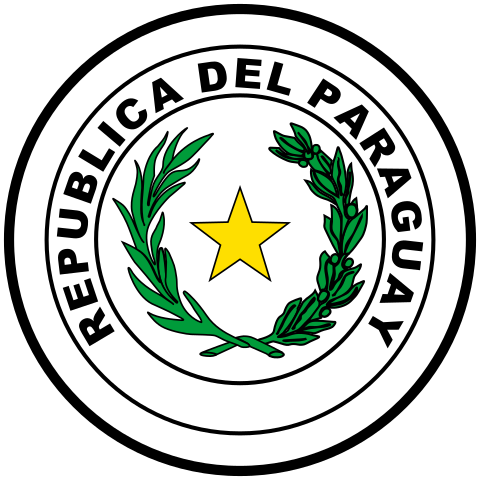More languages
More actions
| Republic of Paraguay República del Paraguay Paraguái Tavakuairetã | |
|---|---|
Motto: Paz y justicia Peace and justice | |
 | |
| Capital and largest city | Asunción |
| Official languages | Spanish Guarani |
| Demonym(s) | Paraguayan |
| Dominant mode of production | Capitalism |
| Government | Unitary presidential republic |
• President | Santiago Peña |
• Vice President | Pedro Alliana |
| Area | |
• Total | 406,752 km² |
| Population | |
• 2024 estimate | 6,218,879 |
| Currency | Guaraní (PYG) |
| Driving side | right |
| Calling code | +595 |
| ISO 3166 code | PY |
| Internet TLD | .py |
Paraguay, officially the Republic of Paraguay is a landlocked country in central South America. It is bordered by Brazil to the north east, Argentina to the south and Bolivia to the north west. The conservative ruling Colorado Party has controlled Paraguay since 1947, with only a brief interruption from 2008 to 2013.[1]
History[edit | edit source]
Spanish colonization[edit | edit source]
Spanish explorers arrived in the region in the early 16th century and laid the foundations for a colony with the capital city of Asunción being founded in 1537. The native Guarani people were dealt with harshly and their lands seized. The colony of Paraguay was included in the larger Viceroyalty of Peru in 1542 and became later became a province of the Viceroyalty of the Río de la Plata after it became a separate entity in 1776.[2]
Independence[edit | edit source]
After the Spanish American wars of independence erupted across the colonies, an uprising occurred in Asunción in May 1811 and ended with the establishment of a revolutionary junta and the declaration of Paraguayan independence.[3]
War of the Triple Alliance[edit | edit source]
In 1864 Brazil, and Argentina invaded Uruguay, a Paraguayan ally, and established a puppet government, Paraguayan President Solano López responded by declaring war. Brazil, Argentina, and the new government of Uruguay then formed an alliance to destroy Paraguay, financially supported by the British. For the next 5 years the three powers committed a genocide against the Paraguayan people, and by the time President Lopez was killed in 1870, only 250,000 people were still alive, less than a 6th of its total population at the start of the war. Following the war Brazil annexed 20,000 square miles of Paraguayan territory and Argentina annexed 36,000 square miles. Paraguay had been the most prosperous country in South America, following the war its population and economy were destroyed, and was subservient to British imperialism.[4]
Stroessner dictatorship (1954 – 1989)[edit | edit source]
In May 1954 Federico Chaves was overthrown in a military coup backed by the U.S. and Brazil and in June a military junta headed by army chief Alfredo Stroessner seized power.[5]
References[edit | edit source]
- ↑ Joel E. Correia (2023-05-31). "Despite Conservative Victory, Paraguay’s Presidential Elections Signal Growing Discontent" NACLA. Archived from the original on 2024-02-18.
- ↑ N. R. Matveeva, V. A. Kharitonov (1979). The Great Soviet Encyclopedia: 'Paraguay; Period of Spanish colonial rule'.
- ↑ N. R. Matveeva, V. A. Kharitonov (1979). The Great Soviet Encyclopedia: 'Paraguay; Formation of an independent state of Paraguay'.
- ↑ Eduardo Galeano (1971). Open Veins of Latin America: Five Centuries of the Pillage of a Continent. [PDF]
- ↑ N. R. Matveeva, V. A. Kharitonov (1979). The Great Soviet Encyclopedia: 'Paraguay; Paraguay in contemporary times'.


